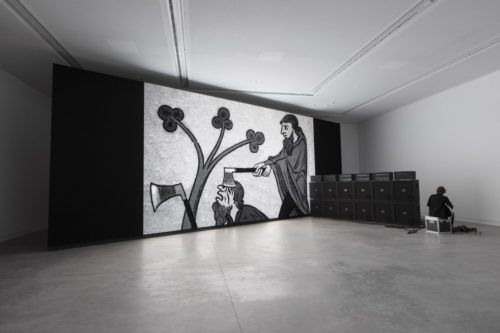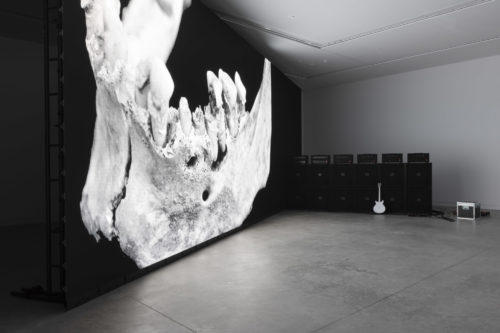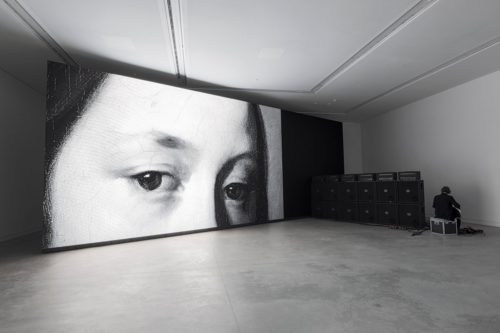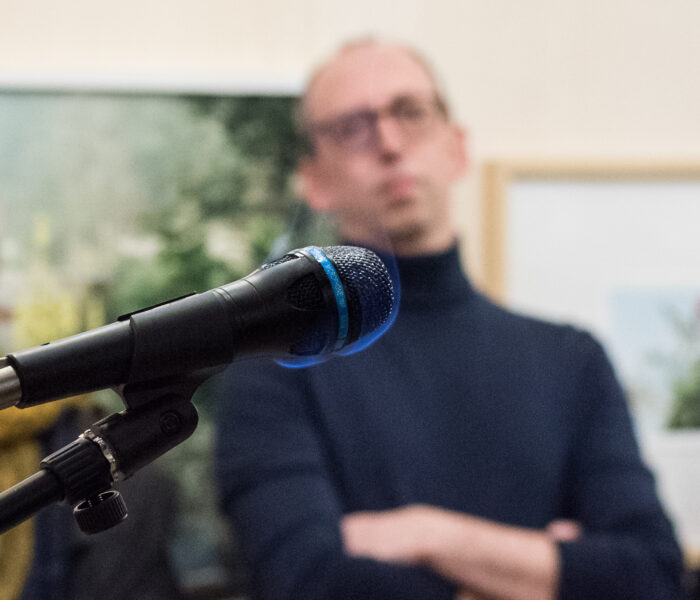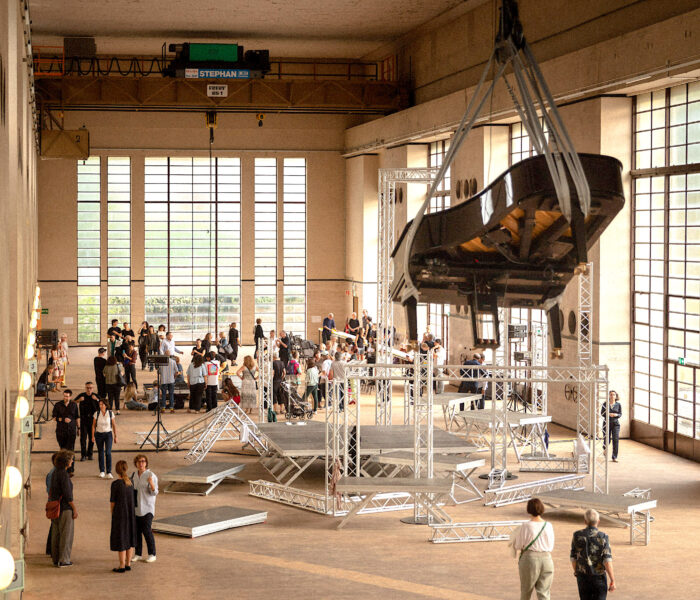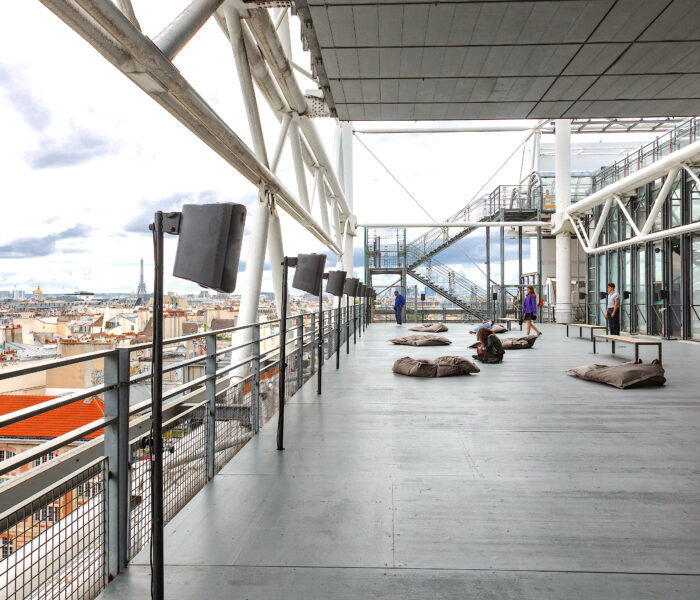Pour illustrer l’intérêt d’Hémisphère son pour la création contemporaine à l’intersection de la musique expérimentale et des arts visuels, et à l’occasion de la 59ème édition de la Biennale d’art contemporain de Venise, un éclairage s’impose sur DESASTRES, l’environnement sonore et intéractif de Marco Fusinato pour le Pavillon australien.
D’emblée, je le reconnais, je n’ai pas visité la Biennale de Venise, mais, parmi les comptes rendus oraux et ceux glanés sur internet et les différents réseaux sociaux, le projet de noise expérimentale de l’artiste multidisciplinaire australien Marco Fusinato retient définitivement l’attention. Après tout, le critique de cinéma Serge Daney s’autorisait bien d’écrire sur les films qu’il n’avait pas vus… Et si je n’ai pas expérimenté le caractère immersif de l’œuvre, j’ai pu appréhender digitalement ses différentes variations hypnotiques documentées au jour le jour sur le compte instagram @desastres_desastres et en saisir la logique aléatoire.
Né en 1964 à Melbourne, issu de parents immigrés italiens originaires des Dolomites, situées à 100 kilomètres au nord de Venise, Marco Fusinato est un habitué de la région. Représenter l’Australie — le pays d’adoption de ses parents — à Venise — la région natale de ses parents pour ainsi dire — a donc la saveur d’une fatalité particulière. Ce n’est pourtant pas la première fois qu’il participe à la Biennale de Venise. Lors de la 56ème édition, et dans le cadre de l’exposition « All the World’s Futures » conçue par le curateur Okwui Enwezor pour le Pavillon international, il avait proposé From the Horde to The Bee, un projet au format radicalement différent de celui présenté en ce moment au Pavillon australien, impliquant la publication à 10.000 exemplaires d’un ouvrage consacré aux archives Primo Moroni, une maison d’édition indépendante installée dans un espace autonome de Milan. Mêlant textes critiques et militants, libelles marxistes et pamphlets anarchistes, l’édition, présentant également un arsenal iconographique de la gauche radicale, était donnée aux visiteurs en échange de dix euros. Au terme de l’exposition, une sculpture de billets organiquement amassés avait remplacé les piles de livres et, suivant le principe de l’économie circulaire, l’argent avait été redistribué en faveur des archives Primo Moroni et des squatteurs de l’espace autonome.
Accompagné par la curatrice Alexie Glass-Kantor, Marco Fusinato a conçu, pour cette 59e édition, une installation dont l’idée s’est développée pendant le confinement dû à la crise sanitaire et même radicalisée au moment de l’invasion russe en Ukraine. DESASTRES — titre inspiré par le groupe de metal japonais Corrupted et le contexte dans lequel le peintre Goya a réalisé la série Los Desastres de la Guerra (1810-1820) — est ainsi le reflet d’un pessimisme actif, de toutes ces frustrations accumulées pendant ce momentum sociopolitique sans précédent tourmenté par la guerre et la pandémie. Quel autre genre musical pourrait constituer si adéquatement la bande-son du chaos contemporain que la noise, le death, black ou doom metal utilisés ici par Fusinato, en dialogue et en disruption avec un répertoire d’images dystopiques voire apocalyptiques diffusé sur écran géant ? Pendant 200 jours, l’architecture du pavillon est ainsi transformée en un studio d’enregistrement et d’improvisation ouvert à tous où l’artiste-musicien, dont l’œuvre croise, depuis la fin des années 1990, les champs visuels et musicaux et explore « les tensions et les contradictions de forces opposées : culture underground / institutions ; bruit / silence ; minimalisme / maximalisme ; pureté / contamination », performe, voire interprète, à la guitare électrique le score proposé par des photographies subversives et violentes, sombres reflets d’une réalité désastreuse, qui défilent à l’écran à un rythme aléatoire.
The artist is present ! Prolétaire revendiqué du monde de l’art, Fusinato offre et dédie toute son énergie, sa vitalité et son labeur au public de la Biennale, s’appliquant à tenir bon chaque jour huit heures durant agrippé à la guitare électrique, improvisant des blocs de bruit, des larsens saturés et des intensités discordantes, au long d’un confinement forcé.
L’esthétique minimaliste et post-punk du projet, étayée par l’austérité du noir et blanc des images et l’intensité du metal, croise l’œuvre sombre et virile de Steven Parrino et les installations immersives de Ryoji Ikeda, et fait culminer les intérêts transversaux de Fusinato pour la musique noise expérimentale, la culture underground, l’histoire de l’art, des luttes politiques et des stratégies de résistance ainsi que le flux ininterrompu des médias de masse. Œuvre ouverte s’il en est, c’est en définitive au public d’interpréter ce dialogue synchronisé entre le son envahissant et le déluge d’images, relayé par un système d’amplification puissant et dont les échos retentissent dans les giardini par-delà l’enceinte du pavillon. Un avertissement, d’ailleurs, à l’entrée du bâtiment prévient que l’installation comprend des sons de haute fréquence et des effets de lumières stroboscopiques. Attention danger pour les yeux et les oreilles ! Fusinato n’est, ici dans cet environnement, presque qu’un facilitateur, un faiseur de bruits, un diffuseur d’images valant pour partition de son point de vue de performeur et opérant comme un test de Rorschach du point de vue du public laissé libre de déchiffrer ces combinaisons audiovisuelles, de se frayer son propre chemin, de méditer au cœur du chaos.
À noter que les 400 pages du catalogue associé à l’exposition et publié aux presses du réel comprennent des textes de la théoricienne et cinéaste Elizabeth Povinelli, de l’historienne de l’art Chus Martinez et des guitaristes Thurston Moore (Sonic Youth) — avec qui Marco Fusinato collabore régulièrement depuis les années 1990 —, Stephen O’Malley (SUNN O)))) et Bruce Russell (Dead C).
Tristan Bera



)



